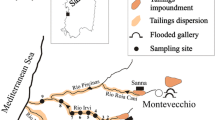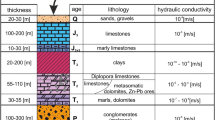Abstract
Closure of Pb-Zn mines in the Iglesias district (SW Sardinia, Italy) caused the cessation of pumping in 1997, and the consequent flooding of underground workings. Deep saline water mixed with the shallow groundwater as the water table rose, increasing salinity. Stratification caused the saline water at depth to settle over a period of three years. At the beginning of rebound, an increase in dissolved Zn, Cd, Pb, and Hg was observed under near-neutral pH conditions. Following peak concentrations, a marked decrease of Zn, Cd, and Hg, and to a lesser extend Pb, occurred. After 7 years of rebound, the concentrations of these metals are relatively low at most mine sites, although the levels are generally still higher than in unmined areas. Nowadays, the highest release of metals to the aquatic system occurs from the weathering of tailings and mine wastes.
Similar content being viewed by others
Author information
Authors and Affiliations
Corresponding author
Rights and permissions
About this article
Cite this article
Cidu, R., Biddau, R. & Spano, T. Temporal Variations in Water Chemistry at Abandoned Underground Mines Hosted in a Carbonate Environment. Mine Water Environ 24, 77–87 (2005). https://doi.org/10.1007/s10230-005-0075-1
Received:
Accepted:
Issue Date:
DOI: https://doi.org/10.1007/s10230-005-0075-1




